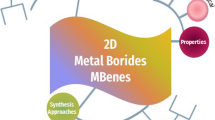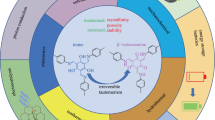Abstract
We designed 12 novel cage-shaped high energy density compounds by incorporating –O– moiety and replacing up to two –NO2 groups at the different positions by –NH2 groups into the basic 2, 4, 6, 8, 10, 12, 13, 14, 15-nonanitro-2, 4, 6, 8, 10, 12, 13, 14, 15 nonaazaheptacyclo [5.5.1.13, 11. 15, 9] pentadecane (NNNAHP) skeleton. Their geometrical structures, electronic structures, heats of formation, detonation properties, thermodynamic properties, thermal stability, impact sensitivity, and free spaces were studied by using density functional theory. The favorable substitution position is a very important factor to tune the detonation properties, thermal stability, and impact sensitivity of the designed compounds. The thermal stability of the designed compounds was analyzed based on the bond dissociation energy of the weakest bond among all the bonds in a compound. The impact sensitivity and free spaces of the designed compounds were compared with well-known cage high energy density compound CL-20. Due to large densities, excellent detonation performance, suitable thermal stability, and low sensitivity, 11 compounds were chosen as potential high energy density compounds having huge potential for their synthesis.










Similar content being viewed by others
References
Talawar M, Sivabalan R, Senthilkumar N, Prabhu G, Asthana S (2004) Synthesis, characterization and thermal studies on furazan- and tetrazine-based high energy materials. J Hazard Mater 113(1–3):11–25
Wei T, Zhu W, Zhang X, Li Y-F, Xiao H (2009) Molecular design of 1, 2, 4, 5-tetrazine-based high-energy density materials. J Phys Chem A 113(33):9404–9412
Wei T, Zhu W, Zhang J, Xiao H (2010) DFT study on energetic tetrazolo-[1, 5-b]-1, 2, 4, 5-tetrazine and 1, 2, 4-triazolo-[4, 3-b]-1, 2, 4, 5-tetrazine derivatives. J Hazard Mater 179(1–3):581–590
Zhu W, Zhang C, Wei T, Xiao H (2011) Computational study of energetic nitrogen-rich derivatives of 1, 1′-and 5, 5′-bridged ditetrazoles. J Comput Chem 32(10):2298–2312
Chi W, Li L, Li B, Wu H (2012) Density functional calculation on a high energy density compound having the formula C2OH4−n (NO2)n. Struct Chem 23(6):1837–1841
Klapötke TM, Piercey DG, Stierstorfer J, Weyrauther M (2012) The synthesis and energetic properties of 5, 7-dinitrobenzo-1, 2, 3, 4-tetrazine-1, 3-dioxide (DNBTDO). Propellants Explos Pyrotech 37(5):527–535
Liu H, Du H, Wang G, Liu Y, Gong X (2012) Molecular design of new nitramine explosives: 1, 3, 5, 7-tetranitro-8-(nitromethyl)-4-imidazolino [4, 5-b] 4-imidazolino-[4, 5-e] pyridine and its N-oxide. J Mol Model 18(4):1325–1331
Klapötke TM, Leroux M, Schmid PC, Stierstorfer J (2016) Energetic materials based on 5, 5′-Diamino-4, 4′-dinitramino-3, 3′-bi-1, 2, 4-triazole. Chem Asian J 11(6):844–851
Jin X, Xiao M, Zhou G, Zhou J, Hu B (2019) Molecule design and properties of bridged 2, 2-bi (1, 3, 4-oxadiazole) energetic derivatives. RSC Adv 9(10):5417–5430
Khan RU, Zhu S, Zhu W (2019) DFT studies on nitrogen-rich pyrazino [2, 3-e] [1, 2, 3, 4] tetrazine–based high–energy density compounds. J Mol Model 25(9):283. https://doi.org/10.1007/s00894-019-4167-4
Paquette LA, Fischer JW, Engel P (1985) Synthesis and X-ray crystal structure analysis of a vicinally dinitro-substituted bishomopentaprismane. J Org Chem 50(14):2524–2527
Ghule V, Jadhav P, Patil R, Radhakrishnan S, Soman T (2009) Quantum-chemical studies on hexaazaisowurtzitanes. J Phys Chem A 114(1):498–503
Tan B, Long X, Li J (2012) The cage strain energies of high-energy compounds. Comput Theor Chem 993:66–72
Lin H, Zhu S-g, Zhang L, Peng X-h, Chen P-y, Li H-z (2013) Theoretical investigation of a novel high density cage compound 4, 8, 11, 14, 15–pentanitro-2, 6, 9, 13–tetraoxa-4, 8, 11, 14, 15-pentaazaheptacyclo [5.5. 1.1 3, 11. 1 5, 9] pentadecane. J Mol Model 19(3):1019–1026
Wang Y, Qi C, Song J-W, Zhao X-Q, Sun C-H, Pang S-P (2013) Trinitromethyl/trinitroethyl substituted CL-20 derivatives: structurally interesting and remarkably high energy. J Mol Model 19(3):1079–1087
Wu Q, Zhu W, Xiao H (2014) Computer-aided design of two novel and super-high energy cage explosives: dodecanitrohexaprismane and hexanitrohexaazaprismane. RSC Adv 4(8):3789–3797
Wu Q, Tan L, Hang Z, Wang J, Zhang Z, Zhu W (2015) A new design strategy on cage insensitive high explosives: symmetrically replacing carbon atoms by nitrogen atoms followed by the introduction of N-oxides. RSC Adv 5(113):93607–93614
Nielsen AT, Chafin AP, Christian SL, Moore DW, Nadler MP, Nissan RA, Vanderah DJ, Gilardi RD, George CF, Flippen-Anderson JL (1998) Synthesis of polyazapolycyclic caged polynitramines. Tetrahedron 54(39):11793–11812
Zhang MX, Eaton PE, Gilardi R (2000) Hepta-and octanitrocubanes. Angew Chem Int Ed 39(2):401–404
Zhang J-y, Du H-c, Wang F, Gong X-d, Ying S-j (2012) Crystal structure, detonation performance, and thermal stability of a new polynitro cage compound: 2, 4, 6, 8, 10, 12, 13, 14, 15-nonanitro-2, 4, 6, 8, 10, 12, 13, 14, 15-nonaazaheptacyclo [5.5. 1.1 3, 11. 1 5, 9] pentadecane. J Mol Model 18(6):2369–2376
Zhang C, Shu Y, Huang Y, Zhao X, Dong H (2005) Investigation of correlation between impact sensitivities and nitro group charges in nitro compounds. J Phys Chem B 109(18):8978–8982
Cao C, Gao S (2007) Two dominant factors influencing the impact sensitivities of nitrobenzenes and saturated nitro compounds. J Phys Chem B 111(43):12399–12402
Liang L, Huang H, Wang K, Bian C, Song J, Ling L, Zhao F, Zhou Z (2012) Oxy-bridged bis (1H-tetrazol-5-yl) furazan and its energetic salts paired with nitrogen-rich cations: highly thermally stable energetic materials with low sensitivity. J Mater Chem 22(41):21954–21964
Pan Y, Zhu W (2018) Designing and looking for novel cage compounds based on bicyclo-HMX as high energy density compounds. RSC Adv 8(1):44–52
Pan Y, Zhu W, Xiao H (2018) Molecular design on a new family of azaoxaadamantane cage compounds as potential high-energy density compounds. Can J Chem 97(2):86–93
Wu Q, Zhu W, Xiao H (2014) A new design strategy for high-energy low-sensitivity explosives: combining oxygen balance equal to zero, a combination of nitro and amino groups, and N-oxide in one molecule of 1-amino-5-nitrotetrazole-3 N-oxide. J Mater Chem A 2(32):13006–13015
Jiao Y, Liu Z, Zhu W (2018) Searching for a new family of modified CL-20 cage derivatives with high energy and low sensitivity. Struct Chem 29(3):837–845
Politzer P, Murray JS (2016) High performance, low sensitivity: conflicting or compatible? Propellants Explosives, Pyrotechnics 41(3):414–425
Frisch M, Trucks G, Schlegel H, Scuseria G, Robb M, Cheeseman J, Scalmani G, Barone V, Mennucci B, Petersson G (2009) Gaussian 09 package. Gaussian Inc, Pittsburgh
Wang F, Du H, Zhang J, Gong X (2011) Computational studies on the crystal structure, thermodynamic properties, detonation performance, and pyrolysis mechanism of 2, 4, 6, 8-tetranitro-1, 3, 5, 7-tetraazacubane as a novel high energy density material. J Phys Chem A 115(42):11788–11795
Pan Y, Li J, Cheng B, Zhu W, Xiao H (2012) Computational studies on the heats of formation, energetic properties, and thermal stability of energetic nitrogen-rich furazano [3, 4-b] pyrazine-based derivatives. Comput Theor Chem 992:110–119
Politzer P, Murray JS, Edward Grice M, Desalvo M, Miller E (1997) Calculation of heats of sublimation and solid phase heats of formation. Mol Phys 91(5):923–928
Byrd EF, Rice BM (2006) Improved prediction of heats of formation of energetic materials using quantum mechanical calculations. J Phys Chem A 110(3):1005–1013
Politzer P, Martinez J, Murray JS, Concha MC, Toro-Labbe A (2009) An electrostatic interaction correction for improved crystal density prediction. Mol Phys 107(19):2095–2101
Kamlet MJ, Jacobs S (1968) Chemistry of detonations. I A simple method for calculating detonation properties of C–H–N–O explosives. J Chem Phys 48(1):23–35
Pospíšil M, Vávra P, Concha MC, Murray JS, Politzer P (2010) A possible crystal volume factor in the impact sensitivities of some energetic compounds. J Mol Model 16(5):895–901
Politzer P, Murray JS (2014) Impact sensitivity and crystal lattice compressibility/free space. J Mol Model 20(5):2223
Ravi P, Gore GM, Sikder AK, Tewari SP (2012) A DFT study on the structure-property relationship of aminonitropyrazole-2-oxides. Int J Quantum Chem 112(6):1667–1677
Murray JS, Politzer P (2011) The electrostatic potential: an overview. Wiley Interdiscip Rev Comput Mol Sci 1(2):153–163
Rice BM, Hare JJ (2002) A quantum mechanical investigation of the relation between impact sensitivity and the charge distribution in energetic molecules. J Phys Chem A 106(9):1770–1783
Scott AP, Radom L (1996) Harmonic vibrational frequencies: an evaluation of Hartree− Fock, Møller− Plesset, quadratic configuration interaction, density functional theory, and semiempirical scale factors. J Phys Chem 100(41):16502–16513
Lide D (2004) The 84th edition of the CRC handbook of chemistry and physics. CRC Press, Boca Raton
Curtiss LA, Raghavachari K, Trucks GW, Pople JA (1991) Gaussian-2 theory for molecular energies of first-and second-row compounds. J Chem Phys 94(11):7221–7230
Curtiss LA, Raghavachari K, Redfern PC, Pople JA (1997) Assessment of Gaussian-2 and density functional theories for the computation of enthalpies of formation. J Chem Phys 106(3):1063–1079
Talawar M, Sivabalan R, Mukundan T, Muthurajan H, Sikder A, Gandhe B, Rao AS (2009) Environmentally compatible next generation green energetic materials (GEMs). J Hazard Mater 161(2–3):589–607
Mader CL (1961) Detonation performance calculations using the Kistiakowsky-Wilson equation of state. Los Alamos Scientific Lab, N. Mex
Türker L, Varisļ S (2017) Defence technology. Interaction
Keshavarz MH, Oftadeh M (2004) New method for estimating the heat of formation of CHNO explosives in crystalline state. High Temp High Pressures 36(4):499
Chung G, Schmidt MW, Gordon MS (2000) An ab initio study of potential energy surfaces for N8 isomers. J Phys Chem A 104(23):5647–5650
Anders G, Borges Jr I (2011) Topological analysis of the molecular charge density and impact sensitivy models of energetic molecules. J Phys Chem A 115(32):9055–9068
Oliveira MA, Borges Jr I (2019) On the molecular origin of the sensitivity to impact of cyclic nitramines. Int J Quantum Chem 119(8):e25868
Pospíšil M, Vávra P, Concha MC, Murray JS, Politzer P (2011) Sensitivity and the available free space per molecule in the unit cell. J Mol Model 17(10):2569–2574
Tsai D, Armstrong R (1994) Defect-enhanced structural relaxation mechanism for the evolution of hot spots in rapidly compressed crystals. J Phys Chem 98(43):10997–11000
Whitea C, Barretta J, Mintmirea J, Elert M, Robertson D (1995) Effects of Nanoscale Voids on the Sensitivity of Model Energetic Materials MRS Online Proceedings Library Archive 418
Rice BM, Mattson W, Trevino SF (1998) Molecular-dynamics investigation of the desensitization of detonable material. Phys Rev E 57(5):5106
Tarver CM, Urtiew PA, Tran TD (2005) Sensitivity of 2, 6-diamino-3, 5-dinitropyrazine-1-oxide. J Energ Mater 23(3):183–203
Lemons DS, Lund CM (1999) Thermodynamics of high temperature, Mie–Gruneisen solids. Am J Phys 67(12):1105–1108
Funding
This work was supported by the National Natural Science Foundation of China (grant no. 21773119) and Science Challenging Program (no. TZ2016001).
Author information
Authors and Affiliations
Corresponding author
Ethics declarations
Conflict of interest
The authors declare that they have no conflict of interest.
Additional information
Publisher’s note
Springer Nature remains neutral with regard to jurisdictional claims in published maps and institutional affiliations.
Rights and permissions
About this article
Cite this article
Khan, R.U., Zhu, W. Designing and looking for novel low-sensitivity and high-energy cage derivatives based on the skeleton of nonanitro nonaaza pentadecane framework. Struct Chem 31, 1387–1402 (2020). https://doi.org/10.1007/s11224-020-01506-y
Received:
Accepted:
Published:
Issue Date:
DOI: https://doi.org/10.1007/s11224-020-01506-y




